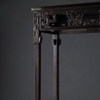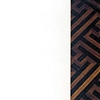Precise, firm, solid notches and pegs were made with the plane, most suitable for carving, making them the best possible choice for furniture making. In that period the regions of Guangdong, Yangzhou, Suzhou and Peking were the most renowned furniture-making centers in China and they made great use of these valuable materials, which were the best and highest quality in furniture making in the country. Gradually, these excellent-quality imported woods, along with internal elements, caused the rigid structure of the furniture and the technical prowess of the Ming dynasty carpenters to develop. Their external appearance was also more in line with customers’ tastes for furniture made of woods of brilliant stable colours and the varied and beautiful types of wood grain. During the first years of the Qing dynasty, the lacquered and huang huali furniture of the Ming dynasty, simple but elegant, was gradually replaced by the zitan wood furniture of great quality and sumptuous style, achieved by carving, incrustations, line drawing and painting. Also, styles were assimilated from many foreign cultures, so that Chinese furniture was continually being renewed. Since then, exquisite, valuable zitan wood furniture had already become a byword for the best quality furniture of the court of the Qing dynasty.
|
810
A RArE ZITAN SIDE TABLE WITH WAN PATTERN
|
|
QIANLONG AND OF THE PERIOD (1736-1795) |
|
Estimate
3,000,000 - 4,000,000 11,538,000 - 15,385,000 387,100 - 516,100
|
|
Sold Price 5,520,000
21,230,769
712,258
|
|
|
Precise, firm, solid notches and pegs were made with the plane, most suitable for carving, making them the best possible choice for furniture making. In that period the regions of Guangdong, Yangzhou, Suzhou and Peking were the most renowned furniture-making centers in China and they made great use of these valuable materials, which were the best and highest quality in furniture making in the country. Gradually, these excellent-quality imported woods, along with internal elements, caused the rigid structure of the furniture and the technical prowess of the Ming dynasty carpenters to develop. Their external appearance was also more in line with customers’ tastes for furniture made of woods of brilliant stable colours and the varied and beautiful types of wood grain. During the first years of the Qing dynasty, the lacquered and huang huali furniture of the Ming dynasty, simple but elegant, was gradually replaced by the zitan wood furniture of great quality and sumptuous style, achieved by carving, incrustations, line drawing and painting. Also, styles were assimilated from many foreign cultures, so that Chinese furniture was continually being renewed. Since then, exquisite, valuable zitan wood furniture had already become a byword for the best quality furniture of the court of the Qing dynasty.






